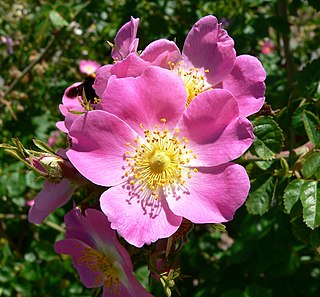
A rose is either a woody perennial flowering plant of the genus Rosa, in the family Rosaceae, or the flower it bears. There are over three hundred species and tens of thousands of cultivars. They form a group of plants that can be erect shrubs, climbing, or trailing, with stems that are often armed with sharp prickles. Their flowers vary in size and shape and are usually large and showy, in colours ranging from white through yellows and reds. Most species are native to Asia, with smaller numbers native to Europe, North America, and Northwest Africa. Species, cultivars and hybrids are all widely grown for their beauty and often are fragrant. Roses have acquired cultural significance in many societies. Rose plants range in size from compact, miniature roses to climbers that can reach seven meters in height. Different species hybridize easily, and this has been used in the development of the wide range of garden roses.

Rosa rugosa is a species of rose native to eastern Asia, in northeastern China, Japan, Korea and southeastern Siberia, where it grows on beach coasts, often on sand dunes. It should not be confused with Rosa multiflora, which is also known as "Japanese rose". The Latin word "rugosa" means "wrinkled", referring to the wrinkled leaves. Often used as an ornamental plant, it has become invasive in parts of Europe, North America and South America.

Rosa multiflora is a species of rose known commonly as multiflora rose, baby rose, Japanese rose, many-flowered rose, seven-sisters rose, Eijitsu rose and rambler rose. It is native to eastern Asia, in China, Japan, and Korea. It should not be confused with Rosa rugosa, which is also known as "Japanese rose", or with polyantha roses which are garden cultivars derived from hybrids of R. multiflora. It was introduced to North America, where it is regarded as an invasive species.

Rosa canina, commonly known as the dog rose, is a variable climbing, wild rose species native to Europe, northwest Africa, and western Asia.
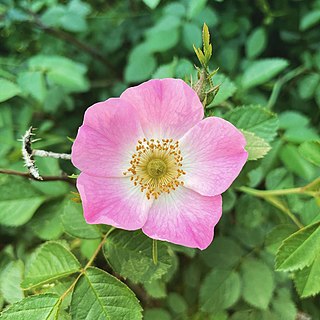
Rosa rubiginosa is a species of rose native to Europe and western Asia.

Rosa 'Ispahan', also known as 'Rose d'Ispahan' and 'Pompon des Princes', is a clear pink, half-open kind of Damask rose, a type of garden rose introduced from the Middle East to Europe during the crusading 13th century.

Rosa gallica, the Gallic rose, French rose, or rose of Provins, is a species of flowering plant in the rose family, native to southern and central Europe eastwards to Turkey and the Caucasus. Rosa gallica was one of the first species of rose to be cultivated in central Europe. It is a parent of several important cultivars.

Rosa pimpinellifolia, the burnet rose, is a species of rose native to western, central and southern Europe and northwest Africa.

Rosa virginiana, commonly known as the Virginia rose, common wild rose or prairie rose, is a woody perennial in the rose family native to eastern North America, where it is the most common wild rose. It is deciduous, forming a suckering shrub up to 2 metres in height, though often less. The stems are covered in numerous hooked prickles. The leaves are pinnate, usually with between 7 and 9 glossy leaflets. The pink flowers are borne singly or in small clusters and appear over a long period in midsummer. The fruits are small, round and bright red, rich in vitamin C and edible, being both used to make jams and tea. It grows in clearings, thickets, and shores. The plant attracts birds, bees, butterflies, and hummingbirds.
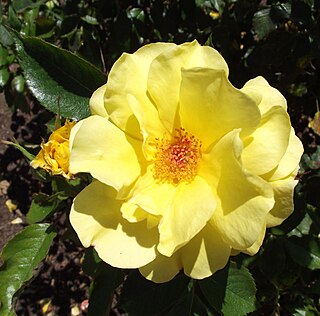
Rosa 'Sun Flare',, is a yellow floribunda rose cultivar, bred by William Warriner and introduced into United States by Jackson & Perkins in 1981. The rose won a gold medal in Japan in 1981, Portland in 1982 and was named an All-America Rose Selections winner in 1983.
Rosa azerbaidshanica is an endemic species of rose, found only in Kalbajar Rayon of Azerbaijan. Most authorities have it as one of the many synonyms of Rosa pulverulenta.

Rosa woodsii is a species of wild rose known by the common names Woods' rose, interior rose, common wild rose, mountain rose, pear-hip rose, and prairie rose.
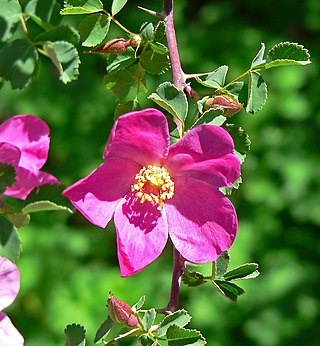
Rosa willmottiae, Miss Willmott's rose or Willmott's rose, is a species in the genus Rosa in the plant family Rosaceae. It grows at an altitude of 2,300–3,150 metres (7,550–10,330 ft) in dry valleys in western Sichuan, China. It forms an arching deciduous shrub 2–3 m high, and as much across. The branches are covered in many straight prickles. The pinnate leaves typically have 7 to 9 small bluish-green leaflets which emit a pleasant fragrance when bruised. It was introduced to western cultivation by Ernest Wilson in 1904 and was named after the collector and horticulturist Ellen Willmott. The flowers are small, lilac-pink, and are borne on short laterals all along the length of the branches in late spring/early summer. The hips are small, becoming orange-red and losing their tips when ripe.
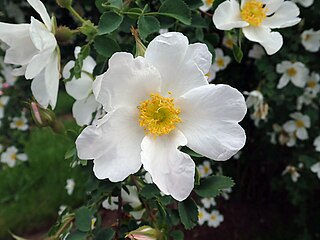
Rosa fedtschenkoana is a species in the plant genus Rosa in the family Rosaceae. Some authorities consider it a synonym of Rosa webbiana. It is native to the foothills of the Ala Tau, Tian Shan and Pamir-Alai mountain ranges in central Asia and northwest China. It is named after Olga Fédchenko, a Russian botanist. It is deciduous, forming a bushy and suckering shrub up to 2.5 metres high and as much across. The branches are covered in many prickles, many of which are fine and straight, but some are thicker and slightly hooked. The pinnate leaves are pale greyish green in colour and have usually between 7 and 9 leaflets. The flowers are white, up to 5 cm across, and are borne singly or in small clusters at the tips of the branches throughout the summer months. The flowers' scent has been described as being "like 'Hovis' [brown] bread with a little blackberry jam". The flowers are followed by small, pear-shaped, bristly orange-red fruits.

Rosa 'Cécile Brünner', also known as 'Mlle Cécile Brünner', 'Sweetheart Rose', 'Malteser Rose', or 'Mignon', is a light pink polyantha rose bred in France by Marie Ducher and introduced by her son-in-law, Joseph Pernet-Ducher in 1881. Its parents were a double-flowered R. multiflora and a hybrid tea rose, either 'Souvenir d'un Ami' or a seedling of 'Mme de Tartas'. It is not clear if the rose was named after the sister (1853–1927) or daughter of Ulrich Brunner fils.

Rosa brunonii is a species of flowering plant in the family Rosaceae. It is commonly known as the Himalayan musk rose. It is a deciduous or semi-evergreen climber that typically grows at altitudes of 1200–2400 meters.

Rosa setigera, commonly known as the climbing rose, prairie rose, and climbing wild rose, is a species of shrub or vine in the Rosaceae (rose) family native to central and eastern North America.

Rosa 'Livin' Easy',, is a floribunda rose cultivar, bred by Jack Harkness. It was introduced into the United States by Weeks Roses in 1992 as 'Fellowship'. The rose was named an All-America Rose Selections winner in 1996.

Rosa 'Gertrude Jekyll' is a pink shrub rose cultivar, bred by British rose breeder, David C. H. Austin in 1986. It was named in honour of the famous British writer and garden designer, Gertrude Jekyll (1843–1932). 'Gertrude Jekyll' is one of the most popular of the David Austin's English roses. It was awarded the Royal Horticultural Society's Award of Garden Merit in 1994.

Rosa sherardii, the northern downy rose or Sherard's downy-rose, is a species of flowering plant in the family Rosaceae. A shrub reaching 2 m (7 ft), it is native to cooler parts of Europe, and has been introduced to the US state of Vermont. In the garden it prefers a sheltered location in full sun with moist but well-drained soil. More compact than Rosa tomentosa, its grey-leaved form in particular is considered under-represented in cultivation.





















